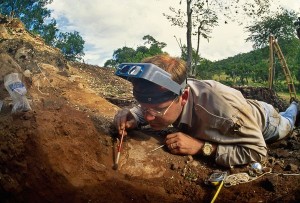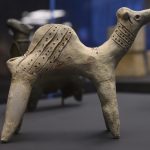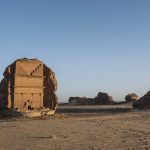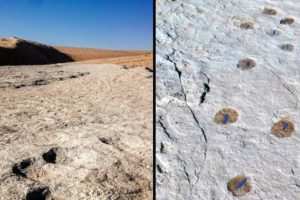
Lee Berger leads a team that will unearth newly discovered fossils.A harrowing expedition into the tiniest recesses of a cave system begins today in South Africa. The effort aims to recover recently discovered fossils of a yet-to-be-identified member of the human family.
Over the next several weeks, the expert team, directed by National Geographic Explorer-in-Residence Lee Berger of South Africa’s University of Witwatersrand, will delve into the Rising Star cave system outside Johannesburg to carefully retrieve the fossils.
Berger’s team made headlines in 2010 with the announcement of the discovery of two skeletons of a new, two-million-year-old hominid species the scientists named Australopithecus sediba. Those finds were made at a site called Malapa Cave, northwest of Johannesburg. (See “Malapa Fossils.”)
Working under Berger’s direction, local cavers made the latest discovery at a site several miles from Malapa. The fossils will be excavated by a team made up of experienced caver-scientists from around the world. All have passed Berger’s requirement of being small enough to fit into and out of cramped cave passages.
Without knowing exactly which species the bones come from, the team hopes their arduous recovery helps answer a broad list of deep questions about humanity’s origins.
What Did Our Ancestors Look Like?
South African sites have long been important to understanding human evolution, beginning with the discovery near Taung of a little skull in 1924 by Raymond Dart, also of the University of Witwatersrand. Dart believed the skull was too primitive to be placed in our own genus Homo, so he gave it in a new genus name: Australopithecus, or “southern (as in Australia) ape.”
Since then, many other specimens of Australopithecus have been recovered in southern and eastern Africa, dating from between four million and two million years ago. The most famous of these is “Lucy,” a 2.8 million-year old skeleton discovered at Hadar in Ethiopia in 1974—still one of the most complete hominid skeletons ever found.
Like other australopithecines, Lucy’s species Australopithecus afarensis walked on two legs, but had much more primitive anatomy and smaller brains than members of our own genus Homo, which gets its name from the Latin for “same” (as in “homophones”).
The earliest specimen of Homo, also from Hadar, is believed to be around 2.5 million years old. It evolved from one of the Australopithecus species, but there is much debate over which one. Many researchers contend that Australopithecus afarensis is the most recent ancestor to Homo. Recently, however, Berger and his colleagues have argued that A. sediba deserves that recognition.
Whichever australopithecine gave birth to Homo, its descendents eventually left Africa at least 1.9 million years ago. Fossils belonging to the species Homo erectus have been found in Africa and across Eurasia. Other than our own species Homo sapiens, the best known group within the Homo lineage is the Neanderthals, who inhabited Europe and western Asia from as early as 600,000 years ago up until around 32,000 years ago.
Some scientists also refer to a third genus of hominid, called Paranthropus. The name combines “para” meaning “next to” or “not quite” (as in “paranormal”) and “anthro” meaning “man” (as in “anthropology” or “android”). Paranthropus had huge, flat teeth and massive jaws. Other scientists prefer to group the Paranthropus specimens in with australopithecines with similar characteristics. Whatever you call these robust specimens, their lineage went extinct some 1.9 million years ago.
How Are We All Related?
Given all the hominids on the scene before our genus, how do we know which ones are actually ancestral to us?
Researchers have spent generations drawing and redrawing a family tree that could connect all the known hominid fossils. Each new find has the possibility of clarifying the picture—or further muddying the water.
Berger’s Australopithecus sediba fossils are without question among the most complete skeletons ever found, rivaling even Lucy. His contention that they are the best candidate to be the immediate ancestor of Homo is based on a suite of features, some even more humanlike than even those of Homo habilis, considered by many scientists to be the earliest member of our genus.
At the same time, A. sediba showed other similarities to much more primitive, tree-dwelling primates. (See “Human Ancestor May Put Twist in Origin Story.”)
It was only the luck of finding the complete skeleton of a previously unknown species that made anyone consider such combinations of traits.
“[With A. sediba,] you have a heel bone and an ankle bone that if you found them independently, you’d put them in different taxa,” said paleontologist Bernard Wood of George Washington University in Washington, D.C.
So does that make it more or less likely to be our ancestor?
“These sorts of issues really need to be worked out by finding a suite of fossils that have some time depth to them,” said Rick Potts, director of the Smithsonian’s Human Origins Program.
Then “you can begin to understand what sort of combination of traits would occur in a small isolated group,” or that would be found in “a lineage with integrity to it [that] you see over and over again for generations.”
These issues are present in a lesser degree for almost all hominid fossils. Each have unique combinations of traits that make them seem so close and yet so far from being a definite ancestor for us. This brings up the next big question.
Who Exactly Were Our Ancestors?
The story of human evolution was once pitched as a search for the “missing link,” an ancient creature that would exhibit traits somewhat like a human, but somewhat like the other great apes. (Also see “New Studies Shake Up Human Tree.”)
After a century of discoveries, it’s clear there wasn’t just a missing link, but rather a whole continuum of different forms, only some of which are directly ancestral to us. Like all species, those in our family tree were shaped by their environments.
“There are multiple places within sub-Saharan Africa that were probably undergoing quite a complex series of responses to environmental variability,” said Potts. It was not just gradual climate change, but rather the kind of instability that is now seen as playing a critical role in driving adaptation and speciation (the formation of new species).
The environmental instability of the time “creates a much more experimental world,” Potts added. “Not a ‘cradle of humankind’—that’s too nurturing. I now prefer the term ‘cauldron of humankind.’
“And it’s much more of a series of broiling events and a churning process full of this sort of experimentation.”
As the landscape changed, diversifying populations could meet back up and essentially jump back into the gene pool together, creating hybrids.
Potts doesn’t suggest hybridization explains all the mixed characteristics in fossils like A. sediba, but says it’s a piece of the puzzle that shouldn’t be forgotten when trying to trace which species absolutely did or did not contribute to the human family line.
What Don’t We Know?
The final driver for continued pursuit of early hominid fossils is the growing awareness of just how much we don’t know.
A. sediba was not only an unknown species until a few years ago, but the place it was discovered also was considered exhausted of all fossils. Berger stresses that our understanding of human evolution is nowhere near complete. We haven’t even finished looking at the things we thought we knew, he says.
“It’s not just a question of finding more fossils,” says GWU’s Bernard Wood. “We need a better understanding of how reliable morphology is for telling us about relationships.”
Follow the New Expedition
The latest chapter in the search for answers is about to kick off in the Rising Star caves, but for now the emphasis is wholly on the search.
“Our aim is to get the fossils out carefully, study them, compare them to other fossil material from around the world, and then proceed to analyze and describe them,” said Berger. He hopes to publish the team’s findings in late 2014. A National Geographic/NOVA documentary will tell the full story of discovery and analysis next fall.
Andrew Howley
National Geographic
Published November 6, 2013















